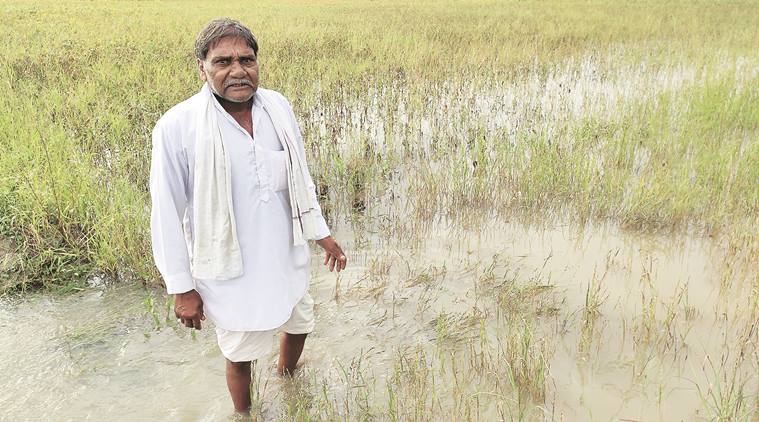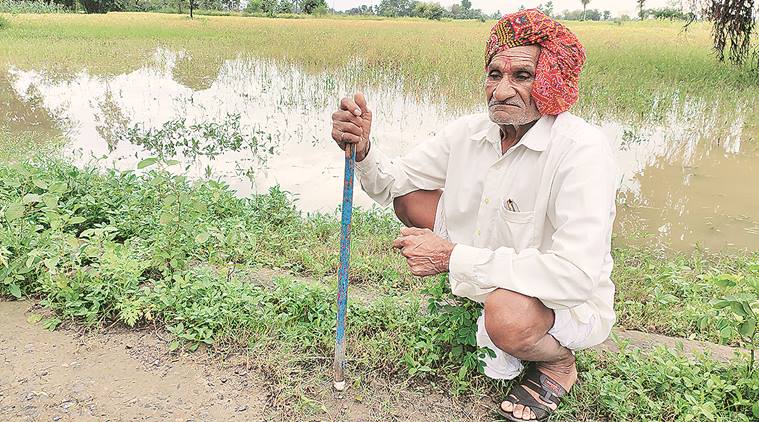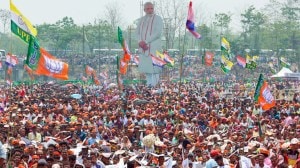- India
- International
Too much of rains have spelt disaster for farmers in India’s soyabean bowl
The average modal price of soyabean in the Ujjain mandi has risen from Rs 3,576 to Rs 3,970 per quintal since the start of this month. The current rates are above the MSP of Rs 3,710 declared by the Modi government for the 2019-20 kharif season.
 Kamal Singh Dhangar at his waterlogged soyabean field in Goradiya Sirajuddin village of Madhya Pradesh’s Sehore district. (Express photo by Milind Ghatwai)
Kamal Singh Dhangar at his waterlogged soyabean field in Goradiya Sirajuddin village of Madhya Pradesh’s Sehore district. (Express photo by Milind Ghatwai)
Standing in ankle-deep water engulfing his field, Kamal Singh Dhangar takes a wild shot at the likely yield from the soyabean crop that practically lies in ruins behind him.
“Ek bora, do bora mushkil (one bag, two bags with difficulty),” notes the 58-year old with a wry smile, minutes after a fresh spell of rains has lashed Guradiya Sirajuddin village in Ashta tehsil of Madhya Pradesh’s (MP) Sehore district. While the same three-acre plot had given nearly 16 quintals of soyabean last year, Dhangar this time isn’t sure he can even afford labourers to harvest the negligible produce staring in his face. He draws solace only from his not being alone. Most farmers in Guradiya Sirajuddin as well as neighbouring villages have reported widespread damage to their already matured standing crop.
Gulab Singh, who owns 10 acres not far from Dhangar’s field, is ruing his decision to have taken an additional six acres of land on lease for cultivating soyabean and wheat this year. “I have paid the owner Rs 1.5 lakh. By now, this soyabean crop should have been ready for taking to Ashta mandi (agriculture produce market at the tehsil town, about 10 km away). But my shauk (expensive pursuit) has proved costly,” remarks the 60-year-old, who, too, cannot enter his field without wading through water almost touching the knees.
Seated at the edge of his flooded field a few hundred meters away, Dev Singh, a sprightly octogenarian, cannot remember the year when the monsoon rains caused such late-stage havoc. “I may have been this big,” he says, pointing to a man many decades younger to him.
Western MP, in which Sehore falls, has received 1,335.4 millimeters of average rainfall from June 1 to September 25, 58% more than the region’s historical normal of 845.3 mm for this period. However, the real story lies in the month-wise figures. In June, the opening month of the southwest monsoon season, the rains were actually 25.6% below the long-period average. In July, they were 31.2% above average. That surplus rose to 63.6% in August, while a whopping 158% more so far this month, confirming Dev Singh’s observation. Worse, there’s little respite, with more rains predicted over the next few days.

The monsoon has taken its toll mainly on soyabean. According to the Union agriculture ministry’s data, a total area of 113.449 lakh hectares (lh) has been planted under this leguminous oilseed in the current kharif season, with the bulk of it accounted for by MP (55.16 lh), Maharashtra (39.595 lh) and Rajasthan (10.608 lh). Within MP, the main soyabean-growing districts are Ujjain, Dewas, Indore, Dhar, Ratlam, Mandsaur, Rajgarh, Shajapur, Sehore and Vidisha. The crop in low-lying areas is the one that has been worst affected.
“Farmers who had sown early-maturity (80-90 days duration) varieties such as JS 9560 and JS 2034 just after mid-June will take the biggest hit. Their crop would already have matured; the longer it remains in the field, the more the chances of the grain rotting. Also, these farmers will not be able to save this grain for using as seed next year,” admits V S Bhatia, director of the Indian Institute of Soyabean Research at Indore.
On the other hand, longer-duration varieties maturing in 95-105 days, like JS 20-69, NRC 86 and JS 97-52, are unlikely to suffer major yield loss, as their grain is not fully ripe yet for harvesting. Moreover, since the rains were poor in June, much of sowing anyway took place in July, thereby further reducing the likelihood of damage. “The vegetative growth and pod formation has been very good. As of now, the overall loss may be 10-15% and the areas where the crop is still good should compensate for those badly impacted,” adds Bhatia.
 Octogenarian farmer Dev Singh. (Express photo by Milind Ghatwai)
Octogenarian farmer Dev Singh. (Express photo by Milind Ghatwai)
The Soyabean Processors Association of India (SOPA), on August 30, reported that water-logging from continuous rains in MP had led to crop damage in “some low lying areas”. But there was “no widespread and excessive damage” and any such reports were “either motivated or put forth without verification,” the Indore-based association had said, based on its own quick crop survey assessment.
“Of course, there is damage to the crop in parts of MP, but I cannot at this moment tell how much. There is also too much unnecessary speculation in the market. At the same time, the Maharashtra crop is excellent,” claims D N Pathak, executive director of SOPA, which is planning to undertake a fresh survey whose report, though, will be ready only by October 10.
This relatively sanguine prognosis is countered by Kedar Sirohi, working president of the ruling Congress party’s Kisan cell. According to him, almost 60% of the crop in the Malwa-Nimad-Bhopal belt that produces over three-fourths of MP’s soyabean has been affected. Incessant rains and the black soils of Malwa-Nimad, which tend to hold water, have resulted in the plants not even growing to full height. The 90-day varieties have not merely matured, but the pods have even started to germinate.
Meanwhile, the average modal price of soyabean in the Ujjain mandi has risen from Rs 3,576 to Rs 3,970 per quintal since the start of this month. The current rates are above the minimum support price of Rs 3,710 declared by the Narendra Modi government for the 2019-20 kharif season.
But all this only cold comfort for Santosh Yadav, 38. He, like other farmers in Lachhirampura village in Ashta, is awaiting clear dry skies for a few days to salvage whatever is left of his crop. With the fields soggy and flooded, using combine harvesters is out of question. That could well mean harvesting labourers raising their rates from Rs 300 to Rs 500 per day. “I have borrowed money from a trader, which has to be repaid once my crop is harvested. Now, that it has nearly failed, he is likely to tell me to simply eat less,” states Yadav half in jest.
This story first appeared in the print edition on September 26, 2019 under the title ‘Wet Woes: Climate and agriculture’.
Apr 18: Latest News
- 01
- 02
- 03
- 04
- 05








































